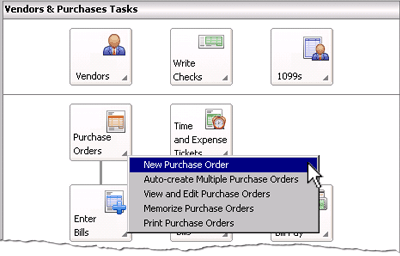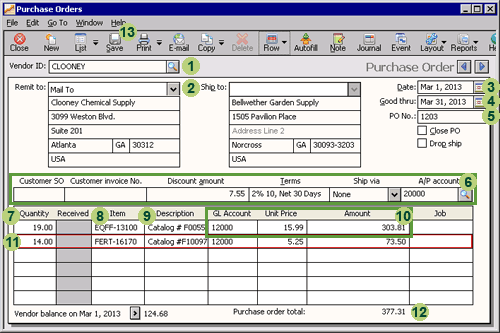Recording a purchase order

Helpful Hint!
If you are completing the Sage 50 Practice Set,
purchase orders are to be recorded in the Purchase Orders window and the invoice created when the
merchandise is received.
One of the first steps in the purchases cycle is placing an
order with a vendor. In general, you can record this event in two different ways.
One way is to create a purchase order
and then to enter the vendor's invoice (bill) into Sage 50 when the items of inventory are received.
Alternatively, if the items are to be received immediately, the second way
is to not create a purchase order and to just enter the vendor invoice
for the purchase.
The approach applied determines when
the purchase information is recorded in the general ledger.
Sage 50 updates the general ledger accounts when the purchase invoice is saved,
not when the purchase order is entered.
When a purchase order is saved in Sage 50, information about the order is
recorded in the purchase order journal. However, entries in this journal are
not posted to the general ledger accounts.
The general ledger is updated only when the related invoice is saved
to recognize the number of items delivered.
Find out how to record a purchase invoice in the
Purchase transactions page in this learning center.
The purchase order functionality in Sage 50 allows you to
predict future expenses.
You can also use it to track how much of the merchandise you have
received and how much is still on order.
This topic shows you where and how to record details of a purchase order in Sage 50.
To record a purchase order in Sage 50, open the Vendors & Purchases Navigation Center.
Click on the Purchase Orders icon and select New Purchase Order from the drop down list provided.

The Purchase Orders window then appears where you can enter purchase order information into Sage 50.
The following screenshot and reference table show step-by-step instructions on
how to enter a purchase order into the Purchase Orders window in Sage 50.
Note that each step is assigned a
reference number to help you identify the appropriate field or icon in the
screenshot.
The Purchase Orders window with reference numbers

| Step |
Sage 50
field or icon |
Action |
 |
Vendor ID |
Select the vendor who will supply the goods.
|
 |
Remit To,
Ship To |
These fields are automatically populated when you select the vendor. You can accept
these default details or change them if required.
|
 |
Date |
Click the calendar icon to select the date of the purchase order. |
 |
Good Thru |
The Good Through date represents the date when the order or at least a portion of the order
is required to
be fulfilled before the order is cancelled. Sage 50 automatically populates the
Good Through date as 30 days after the selected purchase order date.
Accept the default date or click the calendar icon to select the
date by which the purchase order is required to be fulfilled before it is cancelled.
If you are completing the Sage 50 Practice Set,
just use the default date.
|
 |
PO No. |
If you leave the PO No. field blank, Sage 50 will automatically assign a purchase order number
to your purchase order when the purchase order is printed. However, if you are completing the
Sage 50 Practice Set,
you are not asked to print purchase orders. Instead, you are advised of
the purchase order number to use, so you should enter that number into the PO No. field.
|
 |
Various
|
Sometimes a purchase order is created to fulfill a particular order of items from a customer.
In this case you may want to match the purchase order to the sales order or invoice created
specifically for that customer's particular order.
You can enter the corresponding sales order or invoice number
into the relevant fields if known.
The other fields are automatically populated when you select the vendor.
You can accept these default terms
or alter the details if required.
|
 |
Quantity |
Enter the quantity of the first item ordered.
|
 |
Item |
Enter the Item ID of the item of inventory ordered.
|
 |
Description |
When you select the item of inventory using the Item field, Sage 50 automatically populates
this field with the longer description of the item of inventory. Read this description to
check that you have selected the correct item.
|
 |
GL Account,
Unit Price,
Amount,
|
Sage 50 automatically populates these fields with the default information
specified when that item of inventory was set up. You can either accept the default information
or enter any changes directly into the appropriate field. Note that if you change the unit price, Sage 50
automatically calculates the new Amount of the item. Alternatively if you change the total amount,
Sage 50 will calculate and update the Unit Price.
|
 |
New purchase order row
|
You can enter additional items of inventory ordered by repeating steps
7 to 10.
|
 |
Purchase Order Total
|
Sage 50 automatically calculates the total value of the purchase order.
|
 |
 Once you have entered the information in the Purchase Orders window, remember to
review your entries and click the Save icon to record the
purchase order.
Once you have entered the information in the Purchase Orders window, remember to
review your entries and click the Save icon to record the
purchase order.
|
Return to the top